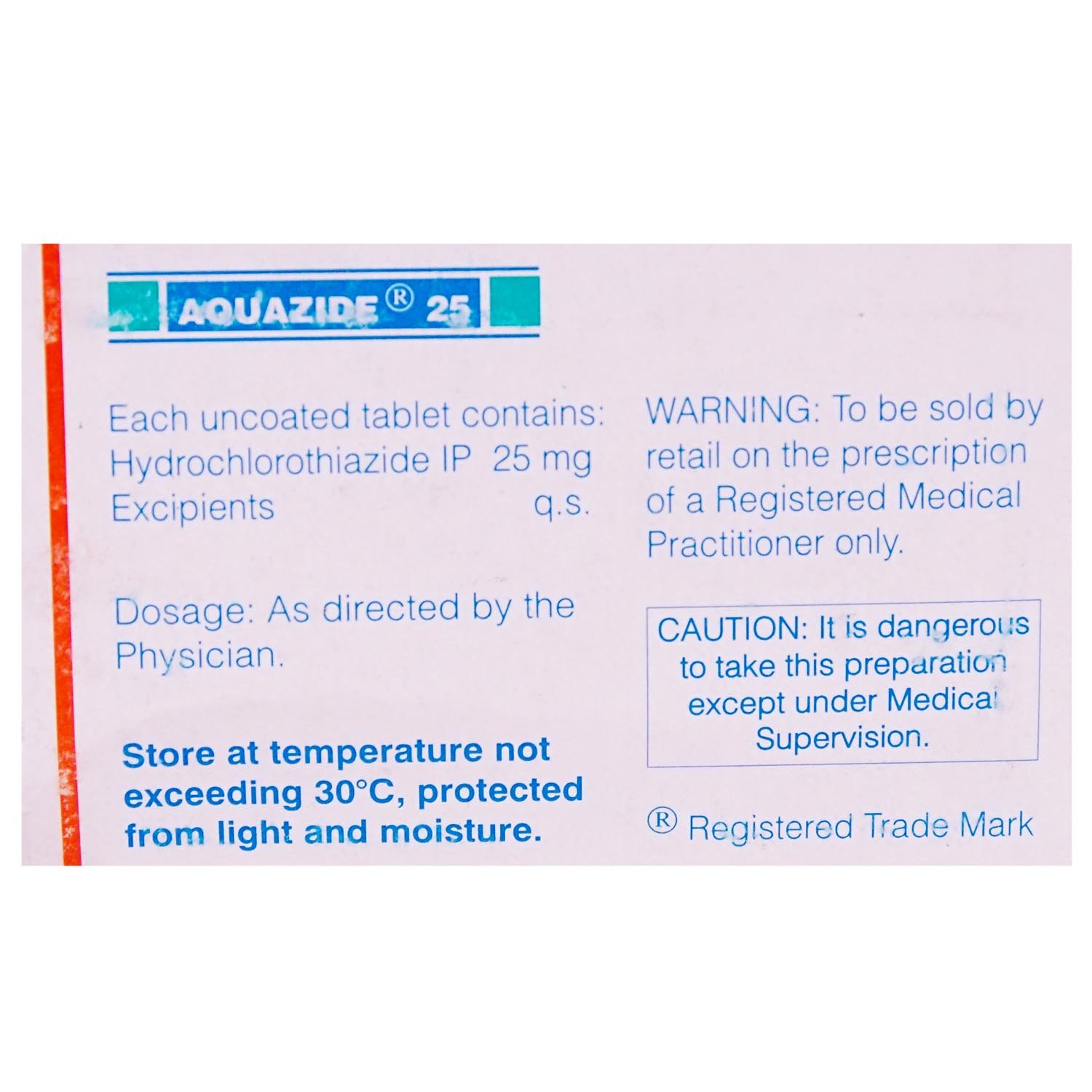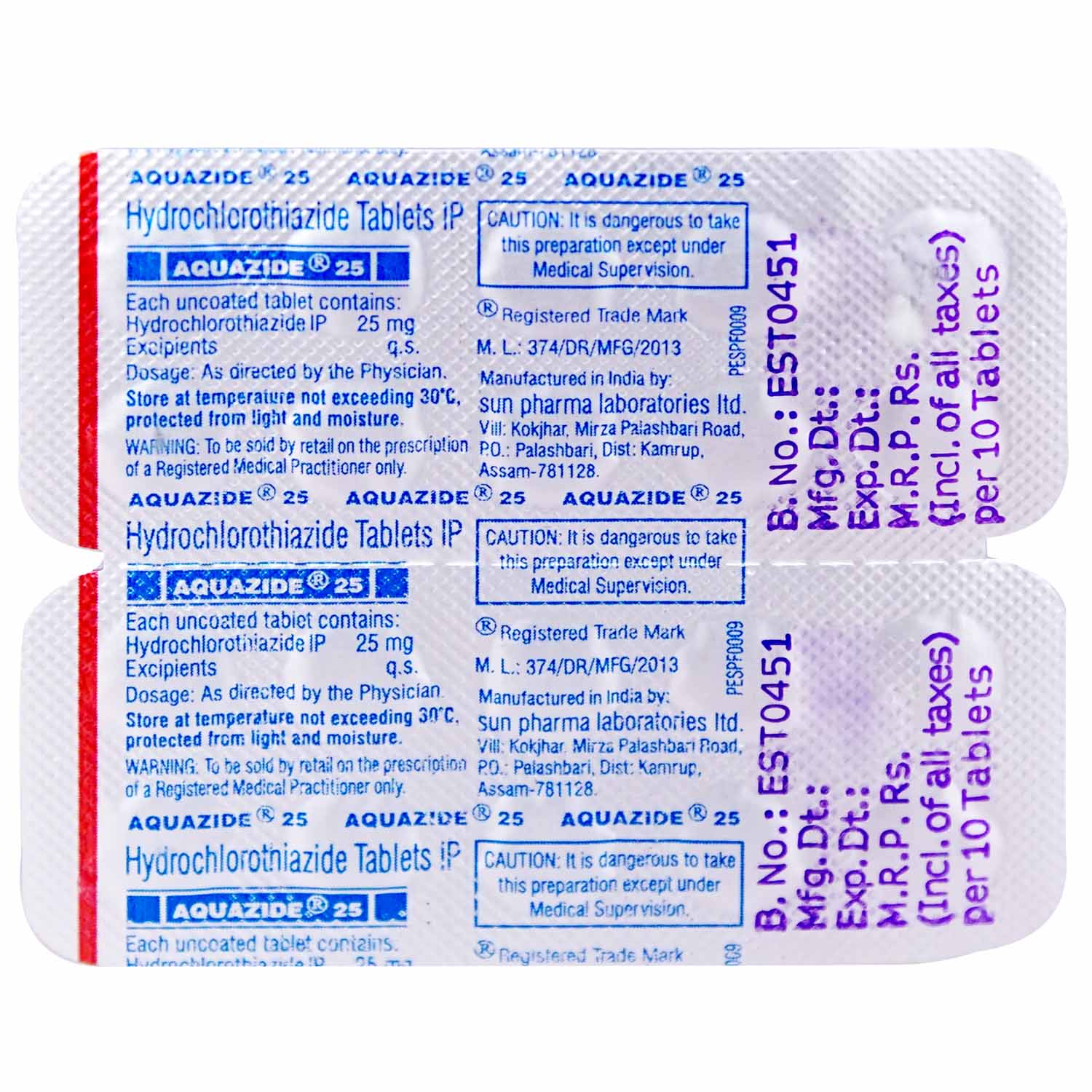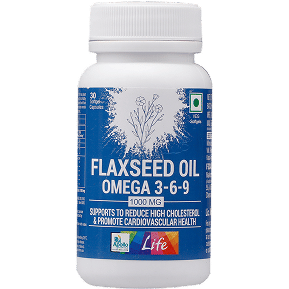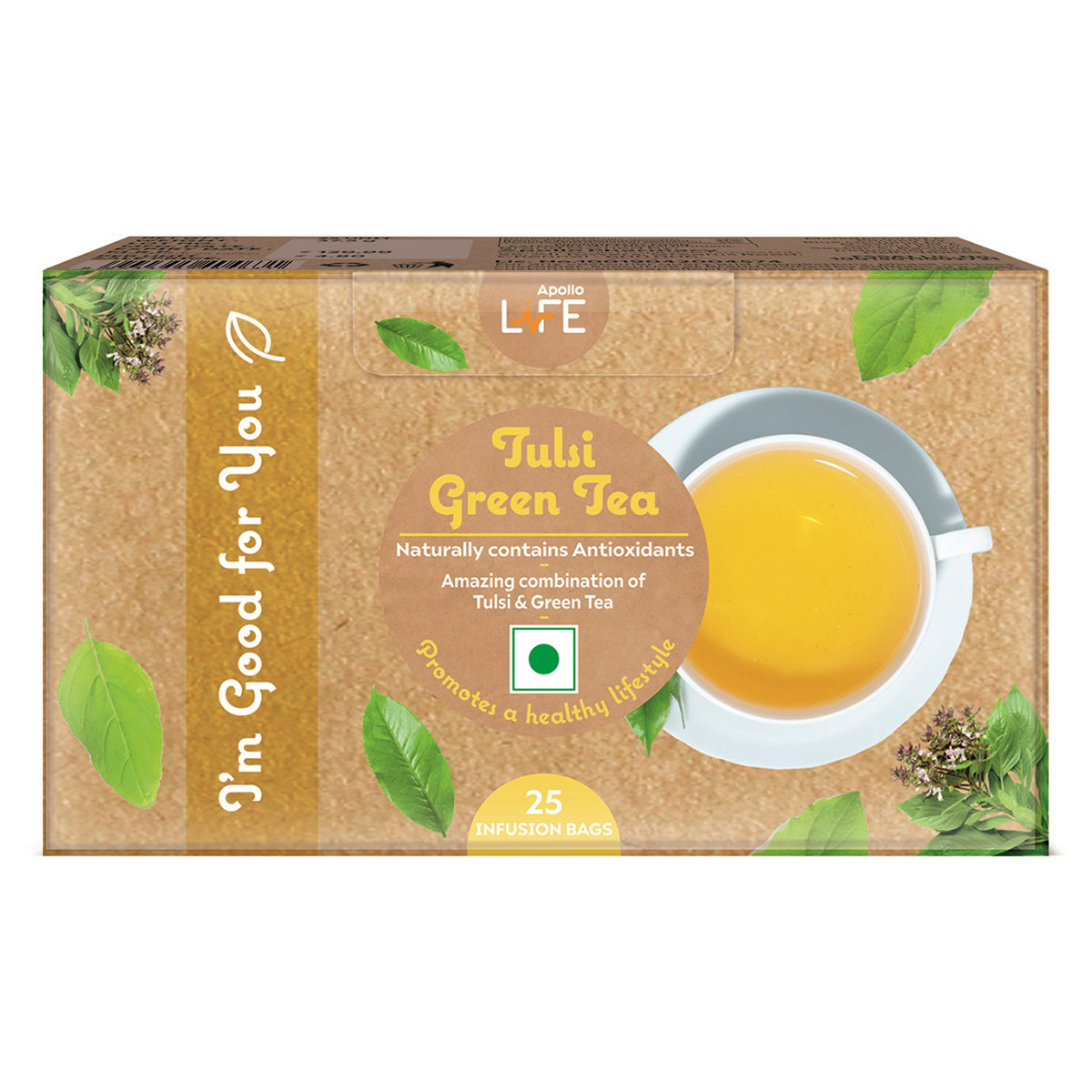Aquazide 25 Tablet



MRP ₹18
(Inclusive of all Taxes)
₹2.7 Cashback (15%)
know your delivery time
Provide Delivery Location
Composition :
Manufacturer/Marketer :
Consume Type :
Expires on or after :
Return Policy :
NPPA :

Secure Payment

Trusted by 8 Crore Indians

Genuine Products
Therapeutic Class
Country of origin
Manufacturer/Marketer address
Author Details
We provide you with authentic, trustworthy and relevant information
Disclaimer
Alcohol
Safe if prescribed
You are recommended not to consume alcohol along with Aquazide 25 Tablet to avoid unpleasant side-effects.
Pregnancy
Consult your doctor
Aquazide 25 Tablet should not be used during pregnancy unless clearly necessary. Your doctor will weigh the benefits and any potential risks before prescribing it to you. Please consult your doctor.
Breast Feeding
Consult your doctor
Aquazide 25 Tablet should not be used when breastfeeding unless clearly necessary. Your doctor will weigh the benefits and any potential risks before prescribing it to you. Please consult your doctor.
Driving
Safe if prescribed
It is not recommended to drive after taking Aquazide 25 Tablet as it may occasionally cause drowsiness.
Liver
Consult your doctor
Aquazide 25 Tablet to be taken with caution, especially if you have a history of liver diseases/conditions. Your doctor may adjust your dose depending upon your current liver conditions.
Kidney
Consult your doctor
Aquazide 25 Tablet to be taken with caution, especially if you have a history of Kidney diseases/conditions. Your doctor may adjust your dose depending upon your current kidney conditions.
Children
Safe if prescribed
Aquazide 25 Tablet to be taken with caution, especially if you are children below the age of 12. Your doctor may adjust your dose depending upon your age.
Product Substitutes
About Aquazide 25 Tablet
Aquazide 25 Tablet belongs to a group of medicines called diuretics (which increase urine production). It is used to treat high blood pressure, heart failure and oedema (a build-up of fluid in the body). Diuretics are sometimes called 'water pills' because they make you urinate more. Besides this Aquazide 25 Tablet is also sometimes used to help you urinate when your kidneys aren't working properly. High blood pressure or hypertension is a chronic condition in which the force exerted by the blood against the artery wall is high. The higher this blood pressure, the harder the heart has to pump. As a result, it leads to heart diseases, irregular heartbeat, and other complications. Oedema (swelling) may occur in case of high blood pressure where fluids of the body get trapped in the tissues of the hands, arms, feet, ankles, and legs.
Aquazide 25 Tablet works by increasing the amount of urine that is passed out from the kidneys. It effectively reduces excess fluid levels in the body and treats oedema (swelling) associated with heart, liver, kidney, or lung disease. This reduces the workload on the heart and makes the heart more efficient at pumping blood throughout the body. Thus, it helps to lower high blood pressure, reducing the chances of heart attack or stroke.
You can take Aquazide 25 Tablet with food or without food. It should be swallowed whole with a glass of water. Do not chew, bite, or break it. Your doctor will advise you on how often you take your tablets based on your medical condition. Sometimes, you may experience dehydration, headache, nausea, or dizziness. Most of these side effects of Aquazide 25 Tablet do not require medical attention and gradually resolve over time. However, if the side effects are persistent, reach out to your doctor.
Try not to stop taking the Aquazide 25 Tablet of your own. Let your doctor know about this, as it may cause a rise in blood pressure and can increase the risk of heart disease and stroke. Inform your doctor if you are suffering from kidney, liver, or heart disease. If you are pregnant or breastfeeding, please tell your doctor so that the dosage of Aquazide 25 Tablet can be prescribed accordingly. Please tell your doctor if you are taking any other medicines or are allergic to Aquazide 25 Tablet . Reducing the amount of table salt (sodium chloride) in your food often relieves the swelling of the body.
Uses of Aquazide 25 Tablet
Medicinal Benefits Mweb
Key Benefits
When you take Aquazide 25 Tablet , the blood vessels in your body will be relaxed, which will help lower the blood pressure. Also, it relaxes the blood vessels and helps to improve the blood flow. It helps in losing out excess fluids from the body by increasing the production of urine. This reduces the workload on the heart and makes the heart more efficient at pumping blood throughout the body. Thus, it helps to lower high blood pressure, reducing the chances of heart attack or stroke. Besides, this relieves oedema and helps you carry out your daily activities more efficiently.
Directions for Use
Side Effects of Aquazide 25 Tablet
- Hypotension (low blood pressure)
- Dehydration
- Headache
- Somnolence (excessive sleepiness)
- Fatigue
- Reduced levels of potassium and magnesium in your blood
Drug Warnings
Before using Aquazide 25 Tablet , tell your doctor if you have liver disease, kidney disease, eye problem (glaucoma), asthma, increased uric acid level (gout), diabetes, or allergic to antibiotics (like sulpha drugs or penicillin). Aquazide 25 Tablet should not be given to the people allergic to Aquazide 25 Tablet , have low blood pressure (less than 90 mm of Hg), or have had a heart attack, kidney disease, or liver disease. Besides this, it is contraindicated in low blood pressure (hypotension), cardiogenic shock (sudden stopping of blood flow to the heart), and aortic stenosis (heart valve problem). Inform your doctor if you are pregnant, suspect you are pregnant, plan to have a baby or if you are breastfeeding; your doctor will prescribe Aquazide 25 Tablet only if the benefits outweigh the risk. Before taking the Aquazide 25 Tablet , inform your doctor about your medical history and ongoing therapies to rule out any potential adverse effects or interactions.
Drug-Drug Interactions
Drug-Drug Interactions
Login/Sign Up
Taking Cisapride and Aquazide 25 Tablet can increase the risk of an irregular heart rhythm which can be severe. The risk increases in patients with a history of heart illness or electrolyte imbalance.
How to manage the interaction:
Combining Cisapride and Aquazide 25 Tablet together is generally avoided as it can possibly result in an interaction, it can be taken if advised by your doctor. However, if you experience any symptoms like dizziness, lightheadedness, fainting, or fast or pounding heartbeats, consult the doctor immediately. Do not stop using any medications without a doctor's advice.
Taking Dofetilide and Aquazide 25 Tablet can increase the risk of an irregular heart rhythm which can be severe. The risk increases in patients with a history of heart illness or electrolyte imbalance.
How to manage the interaction:
Combining Dofetilide and Aquazide 25 Tablet together is not recommended as it can possibly result in an interaction, it can be taken if advised by your doctor. However, if you experience any symptoms like sudden dizziness, lightheadedness, fainting, shortness of breath, chest pain or tightness, rapid heartbeat, or memory loss, contact your doctor immediately. Do not discontinue any medications without consulting a doctor.
Coadministration of Amiodarone together with Aquazide 25 Tablet may raise the risk of an abnormal heart rhythm.
How to manage the interaction:
Even though Amiodarone and Aquazide 25 Tablet interact, they can be used if prescribed by a doctor. If you have cardiac problems or electrolyte imbalances, you may be at greater risk. If you experience abrupt dizziness, lightheadedness, fainting, shortness of breath, or rapid heartbeat, Weakness, tiredness, drowsiness, confusion, painful muscle cramping, dizziness, nausea, or vomiting, get medical attention. Do not discontinue any medications without consulting a doctor.
The combined use of Tizanidine and Aquazide 25 Tablet can have additive effects in lowering your blood pressure.
How to manage the interaction:
Taking Tizanidine and Aquazide 25 Tablet together can possibly result in an interaction, but they can be taken if advised by your doctor. However, if you experience any symptoms like headache, dizziness, lightheadedness, fainting, and changes in pulse or heart rate, consult a doctor immediately. Do not stop using any medications without a doctor's advice.
Co-administration of Dronedarone and Aquazide 25 Tablet can increase the risk of severe irregular heart rhythm which can be severe. The risk increases in patients with a history of heart illness or electrolyte imbalance.
How to manage the interaction:
Taking Dronedarone and Aquazide 25 Tablet together is avoided as it can possibly result in an interaction, it can be taken if advised by your doctor. However, if you experience any symptoms like dizziness, lightheadedness, fainting, fast heartbeats, weakness, tiredness, drowsiness, confusion, muscle pain, cramps, nausea, or vomiting, consult the doctor immediately. Do not stop using any medications without a doctor's advice.
Co-administration of Droperidol and Aquazide 25 Tablet can increase the risk of an irregular heart rhythm which can be severe. The risk increases in patients with a history of heart illness or electrolyte imbalance.
How to manage the interaction:
Taking Droperidol and Aquazide 25 Tablet together can possibly result in an interaction, but they can be taken if advised by your doctor. However, consult the doctor immediately if you experience any symptoms like dizziness, lightheadedness, fainting, fast heartbeats, weakness, tiredness, drowsiness, confusion, muscle pain, cramps, nausea, or vomiting. Do not stop using any medications without a doctor's advice.
Taking Ziprasidone and Aquazide 25 Tablet can increase the risk of an irregular heart rhythm which can be severe. The risk increases in patients with a history of heart illness or electrolyte imbalance.
How to manage the interaction:
Taking Ziprasidone and Aquazide 25 Tablet together is avoided as it can possibly result in an interaction, but it can be taken together if prescribed by a doctor. However, consult your doctor if you experience sudden dizziness, lightheadedness, fainting, shortness of breath. Do not discontinue any medications without consulting a doctor.
Coadministration of Aminolevulinic acid with Aquazide 25 Tablet can make your skin more sensitive to bright lights. This could increase the risk or severity of developing a sunburn.
How to manage the interaction:
Although there is a possible interaction between Aminolevulinic acid and Aquazide 25 Tablet, it can be taken if advised by your doctor. Avoid exposure of the eyes and skin to sunlight or bright indoor lights for 48 hours. Do not stop using any medications without a doctor's advice.
Coadministration of Lithium and Aquazide 25 Tablet can increase the effects of lithium.
How to manage the interaction:
Taking Lithium and Aquazide 25 Tablet together can possibly result in an interaction, but it can be taken if advised by your doctor. However, if you experience any symptoms like loose stools, vomiting, drowsiness, shaking of hands and legs, thirst, increased urination, lack of coordination, or muscle weakness, consult the doctor immediately. Do not stop using any medications without a doctor's advice.
Co-administration of Arsenic trioxide and Aquazide 25 Tablet can increase the risk of an irregular heart rhythm which can be severe. The risk increases in patients with a history of heart illness or electrolyte imbalance.
How to manage the interaction:
Taking Arsenic trioxide and Aquazide 25 Tablet together is avoided as it can possibly result in an interaction, it can be taken if advised by your doctor. However, if you experience any symptoms like dizziness, lightheadedness, fainting, fast heartbeats, weakness, tiredness, drowsiness, confusion, muscle pain, cramps, nausea, or vomiting. consult the doctor immediately. Do not stop using any medications without a doctor's advice.
Drug-Food Interactions
Drug-Food Interactions
Login/Sign Up
Drug-Diseases Interactions
Drug-Diseases Interactions
Login/Sign Up
Drug-Drug Interactions Checker List
- METOPROLOL
- RAMIPRIL
- ATORVASTATIN
- CARBAMAZEPINE
- PHENOBARBITAL
Habit Forming
Special Advise
- The monitoring of serum electrolytes is particularly important while taking hydrochlorothiazide.
Diet & Lifestyle Advise
- Consume antioxidant-rich food. Blueberries, cherries, tomatoes, squash, and bell peppers are high in antioxidants.
- Eat natural diuretic foods. Asparagus, beets, green beans, grapes, onion, leafy greens, pineapple, leeks, pumpkin, and garlic are all-natural diuretic foods.
- Use healthy cooking oils like soybean, olive, canola, and coconut oil.
- You should avoid refined foods such as white bread, spaghetti, sugar, and red meat.
- Reduce or eliminate Trans fatty acids, which are found in commercially baked items such as cookies, cakes, crackers, French fries, onion rings, doughnuts, and processed foods.
- Avoid consumption of too much salt or salty food.
- Keep your weight under control with a BMI of 19.5-24.9.
- Regular physical activity or exercise like walking improves your blood flow.
- When possible, elevate your legs or the swollen area on a chair or pillows.
- Avoid standing or sitting for extended periods of time.
- Avoid chronic stress as it can raise your blood pressure.
- Spend time with your loved ones to cope with stress and practice mindfulness techniques.
- Quitting smoking and alcohol consumption is the best strategy to lower the risk of many health complications.
All Substitutes & Brand Comparisons
RX
Out of StockTHIAZIDE 25MG TABLET
Ordain Health Care Global Pvt Ltd
₹17.7
(₹1.59 per unit)
1% CHEAPERRX
Out of StockHydride-25 Tablet 10's
Micro Labs Ltd
₹18.5
(₹1.67 per unit)
3% COSTLIERRX
Out of StockChlorotag 25mg Tablet
Ikon Remedies Pvt Ltd
₹18.9
(₹1.7 per unit)
4% COSTLIER

Have a query?
Buy best Cardiology products by
Torrent Pharmaceuticals Ltd
Sun Pharmaceutical Industries Ltd
Lupin Ltd
Intas Pharmaceuticals Ltd
Cipla Ltd
Micro Labs Ltd
Macleods Pharmaceuticals Ltd
Abbott India Ltd
Ajanta Pharma Ltd
Ipca Laboratories Ltd
Eris Life Sciences Ltd
Mankind Pharma Pvt Ltd
Lloyd Healthcare Pvt Ltd
Dr Reddy's Laboratories Ltd
Glenmark Pharmaceuticals Ltd
Emcure Pharmaceuticals Ltd
Alembic Pharmaceuticals Ltd
Alkem Laboratories Ltd
East West Pharma India Pvt Ltd
USV Pvt Ltd
Zydus Healthcare Ltd
Aristo Pharmaceuticals Pvt Ltd
Elbrit Life Sciences Pvt Ltd
J B Chemicals & Pharmaceuticals Ltd
Zydus Cadila
Akumentis Healthcare Ltd
Alteus Biogenics Pvt Ltd
Hbc Life Sciences Pvt Ltd
Fusion Health Care Pvt Ltd
Troikaa Pharmaceuticals Ltd
La Renon Healthcare Pvt Ltd
Corona Remedies Pvt Ltd
Jubilant Lifesciences Ltd
Medley Pharmaceuticals Ltd
Knoll Healthcare Pvt Ltd
Msn Laboratories Pvt Ltd
Zuventus Healthcare Ltd
Cadila Pharmaceuticals Ltd
Blue Cross Laboratories Pvt Ltd
Lividus Pharmaceuticals Pvt Ltd
Morepen Laboratories Ltd
Ranmarc Labs
Shrrishti Health Care Products Pvt Ltd
Sanofi India Ltd
Steris Healthcare
Elder Pharmaceuticals Ltd
Primus Remedies Pvt Ltd
Unison Pharmaceuticals Pvt Ltd
Eswar Therapeutics Pvt Ltd
Knoll Pharmaceuticals Ltd
Tas Med India Pvt Ltd
Systopic Laboratories Pvt Ltd
Indiabulls Pharmaceuticals Pvt Ltd
Leeford Healthcare Ltd
Sinsan Pharmaceuticals Pvt Ltd
Biochem Pharmaceutical Industries Ltd
Cadila Healthcare Ltd
Azkka Pharmaceuticals Pvt Ltd
Nirvana India Pvt Ltd
Orsim Pharma
Prevego Healthcare & Research Pvt Ltd
Econ Healthcare
Elinor Pharmaceuticals (P) Ltd
FDC Ltd
Sunij Pharma Pvt Ltd
Nicholas Piramal India Ltd
Astra Zeneca Pharma India Ltd
Pfizer Ltd
Lia Life Sciences Pvt Ltd
Shine Pharmaceuticals Ltd
Elicad Pharmaceuticals Pvt Ltd
Indoco Remedies Ltd
Proqol Health Care Pvt Ltd
Vasu Organics Pvt Ltd
Biocon Ltd
Opsis Care Lifesciences Pvt Ltd
Johnlee Pharmaceuticals Pvt Ltd
Merck Ltd
Wockhardt Ltd
Auspharma Pvt Ltd
Ergos Life Sciences Pvt Ltd
Lakshya Life Sciences Pvt Ltd
Ordain Health Care Global Pvt Ltd
Pficus De Med Pvt Ltd
ALICAN PHARMACEUTICAL PVT LTD
RPG Life Sciences Ltd
Glynis Pharmaceuticals Pvt Ltd
Orris Pharmaceuticals
Samarth Life Sciences Pvt Ltd
Aprica Pharmaceuticals Pvt Ltd
Aretaeus Pharmaceuticals Pvt Ltd
Koye Pharmaceuticals Pvt Ltd
Neocardiab Care
Retra Life Science Pvt Ltd
Alniche Life Sciences Pvt Ltd
Alvio Pharmaceuticals Pvt Ltd
Arkas Pharma Pvt Ltd
Atos Lifesciences Pvt Ltd
Divine Savior Pvt Ltd
Metalis Lifesciences Pvt Ltd
Customers Also Bought
Recommended for a 30-day course: 3 Strips









